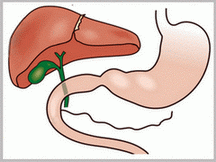
Gallbladder symptoms
Table of Contents
About me
Categories
Text
Gallstones may be present for decades before symptoms develop, and 70% to 80% of patients remain asymptomatic throughout their lives. It appears that asymptomatic patients convert to symptomatic ones at the rate of 1% to 3% per year, and the risk diminishes with time. Prominent among symptoms is biliary pain, which tends to be constant, or an excruciating "colicky" (spasmodic) pain due to the obstructive nature of gallstones in the gallbladder or biliary tree proper. Inflammation of the gallbladder, in association with stones, also generates pain. More severe complications include empyema, perforation, fistulas, inflammation of the biliary tree (cholangitis), and obstructive cholestasis or pancreatitis with ensuant problems. The larger the stones, the less likely they are to enter the cystic or common ducts to produce obstruction--it is the very small stones, or "gravel," that are the more dangerous. A large stone may occasionally erode directly into an adjacent loop of small bowel, generating intestinal obstruction ("gallstone ileus"). On occasion, progressive mucosal removal of luminal lipids in obstructed, uninflamed gallbladders may leave clear mucinous secretions, so-called hydrops or mucocele of the gallbladder. Most notable is the increased risk for carcinoma of the gallbladder.
Patients with acute calculous cholecystitis usually but not always have experienced previous episodes of biliary pain. Acute calculous cholecystitis may appear with remarkable suddenness and constitute an acute surgical emergency, or it may present with mild symptoms that resolve without medical intervention. An attack of acute cholecystitis begins with progressive right upper quadrant or epigastric pain, frequently associated with mild fever, anorexia, tachycardia, diaphoresis, and nausea and vomiting. The upper abdomen is tender, but a distended tender gallbladder is not usually evident. Most patients are free of jaundice; the presence of hyperbilirubinemia suggests obstruction of the common bile duct. Mild to moderate leukocytosis may be accompanied by mild elevations in serum alkaline phosphatase values. In the absence of medical attention, the attack usually subsides in 7 to 10 days and frequently within 24 hours. However, up to 25% of patients develop progressively more severe symptoms, requiring immediate surgical intervention. In those patients who recover, recurrence is common.
Clinical symptoms of acute acalculous cholecystitis tend to be more insidious, since symptoms are obscured by the underlying conditions precipitating the attacks. A higher proportion of patients have no symptoms referable to the gallbladder; diagnosis therefore rests on a high index of suspicion. In the severely ill patient, early recognition of this condition is crucial, since failure to do so almost ensures a fatal outcome. A more indolent form of acute acalculous cholecystitis may occur in the outpatient population in the setting of systemic vasculitis, severe atherosclerotic ischemic disease in the elderly, and acquired immunodeficiency syndrome (with infection).
Chronic cholecystitis does not have the striking manifestations of the acute forms and is usually characterized by recurrent attacks of either steady or colicky epigastric or right upper quadrant pain. Nausea, vomiting, and intolerance for fatty foods are frequent accompaniments.
Labels: Gallbladder symptoms
3 Comments:

http://kidbuxblog.com/removing-gallstones-naturally/
This medicine is available in powder form n have no any side effect.After yrs.of research,we present a miracle stone dissolving package,cost 2000/-for complete course of 6 weeks treatment. Our medicine doesn't only dissolve kidney stones,instead it destroy the root causes n we guarantees that u will never get Kidney stone again in ur rest of life.If u have any query then Contact to...Dr.R.K.Rishi,BAMS,MD(A.Medicine).Varanasi. Mob. 09889971201
FOR MORE INFORMATION KINDLY CLICK HERE